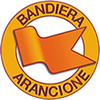Churches Cathedrals
Church of Madonna dei Lumi
On the left side of the sentry lodge surmounting Porta San Giovanni, there is a small bell tower rising above the right nave of a seventeenth-century church, "Madonna dei Lumi", today mostly destroyed.
This baroque church was built in the early seventeenth century on the bold project by the local architect Francesco Panzini, who designed an elevated church. The church rose at the beginning of Via San Giovanni, closing the street. The entrance to the church was via a balcony, by climbing two flights of stairs from Via San Giovanni.
The church was dedicated to an ancient image of Virgin Mary, frescoed in a niche of the inner wall above the front door. This image, restored by Lorenzo Ciardi in 1522, had miraculously appeared to the local people surrounded by lights ("lumi").
Approx. three centuries later, the central nave was demolished, since it made the street too dark and impassable for the new means of transport. Its arches and its brick columns along the two side naves are still visible today. One of the naves, the one underneath the small bell tower, is open to the public and gives the name to the adjacent tiny square, "Piazzetta della Madonna", that can be reached by climbing a staircase, larger than the original one, on the left side of Via San Giovanni.
Remains of the Church of San Francesco
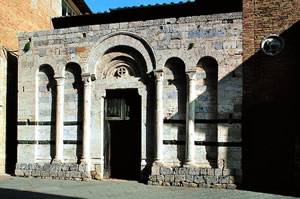 The remains of the church of Convento di San Francesco lie on a widening, on the right side of Via San Giovanni, a few steps after the entrance gate, the homonymous Porta San Giovanni. Its beautiful white-travertine façade, sided by two brick houses, has horizontal stripes of dark serpentine that recalls the Pisan style. The portal is surmounted by a double arch enclosing the symbol of the knights of Jerusalem, the rich order of warrior monks whose task was defending the Holy Sepulchre. These remains give evidence for the severe beauty of this church belonging to the Franciscan Order, originally a Magione of the Knights with a hospice for the many pilgrims and travellers along the Via Francigena.
The remains of the church of Convento di San Francesco lie on a widening, on the right side of Via San Giovanni, a few steps after the entrance gate, the homonymous Porta San Giovanni. Its beautiful white-travertine façade, sided by two brick houses, has horizontal stripes of dark serpentine that recalls the Pisan style. The portal is surmounted by a double arch enclosing the symbol of the knights of Jerusalem, the rich order of warrior monks whose task was defending the Holy Sepulchre. These remains give evidence for the severe beauty of this church belonging to the Franciscan Order, originally a Magione of the Knights with a hospice for the many pilgrims and travellers along the Via Francigena.
Santa Fina's house
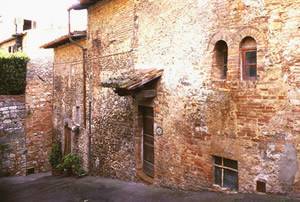 From Piazza della Cisterna, walking down Via Del Castello for a 100m, an archway on the right opens into a dark narrow passage that rapidly leads to Santa Fina's House.
From Piazza della Cisterna, walking down Via Del Castello for a 100m, an archway on the right opens into a dark narrow passage that rapidly leads to Santa Fina's House.
This young blessed virgin endured long physical and material suffering that she accepted for Christ's sake. Assisted with love by her wetnurse Beldie, who remained at her side after her mother's death, Fina lay for most of her short life on a wooden board in the cellar of her poor house. Today a chapel, Santa Fina's house is viewable every year on12th March, the saint's day. They say that shortly before her death, St Gregorio appeared to the saint foretelling the end of her mortal life. After her death, angels rang the local bells; small yellow flowers, today called "viole di Santa Fina" (St Fina's violets) came out on the towers and city walls.
Fina, who has never been declared saint by the Church, really lived in San Gimignano, and after many centuries local people still worship her.
Museum of sacred Art
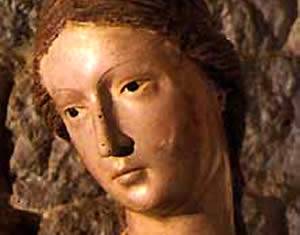 The Museum was created in 1915. It has recently been reorganized and includes works of art from convents, the Duomo and from churches of the area. The display exhibits remarkable paintings, sculptures, earthenware, rests of funerary monuments, bas-relieves, textiles and silverware.
The Museum was created in 1915. It has recently been reorganized and includes works of art from convents, the Duomo and from churches of the area. The display exhibits remarkable paintings, sculptures, earthenware, rests of funerary monuments, bas-relieves, textiles and silverware.
Very interesting are the wooden sculptures dating from the 14th century: "The announcing Angel" and the "The Madonna", of which only the head and the shoulders still exist and the splendid illuminated psalm books and antiphonaries (books that contain verses which precede psalms) of Niccolò di Ser Sozzo and Lippo Vanni. "The Madonna of the Rose" (see picture above), part of a triptych by Bartolo di Fredi, is particularly loved from the inhabitants of San Gimignano.
In the Sacred Furniture room a precious enamelled cross from the beginning of XIV century and other extremely finely worked examples of goldsmith's art, embossed and engraved work can be admired.
In the vestment room are exposed lot of pieces from the very best craftsmanship that mostly date back to the 17th and 18th century as the "Paliotto delle colombe d'oro", that is a rare example of exceptional textile craftsmanship of the XV century.
In the same room is exposed a remarkable polychrome wooden statue from the beginning of XIV century from Francesco da Valdambrino that represents Sant'Antonio Abate.
The Duomo of San Gimignano
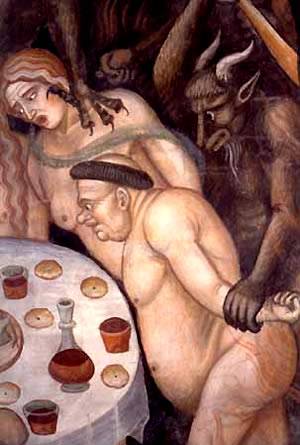 The Duomo or Collegiate Church situated on the west side of the Duomo square is a remarkable monument of Romanesque architecture in Tuscany. The Duomo is considered to be both a Temple of Faith and of Art and indeed, some works of art still in the church, or from there moved to the Town Museums, were financed and created thanks to donations or offerings. In the archives there are wills bearing testimony to this devotion that were made by both illustrious and simple persons. Altars, chapels, freizes, frescoes, paintings commissioned from the most famous artists by the persons responsible for the Opera del Duomo, by public administrators and private citizens, all have contributed to make this church more beautiful and rich in works of art. Originally the present church was a simple parish church that in 1056 was transformed into a Propositura (the name given to a parish church responsible for other small parish churches in the surrounding area) by Pope Vittore II. In 1148 the Duomo was consecrated by Pope
The Duomo or Collegiate Church situated on the west side of the Duomo square is a remarkable monument of Romanesque architecture in Tuscany. The Duomo is considered to be both a Temple of Faith and of Art and indeed, some works of art still in the church, or from there moved to the Town Museums, were financed and created thanks to donations or offerings. In the archives there are wills bearing testimony to this devotion that were made by both illustrious and simple persons. Altars, chapels, freizes, frescoes, paintings commissioned from the most famous artists by the persons responsible for the Opera del Duomo, by public administrators and private citizens, all have contributed to make this church more beautiful and rich in works of art. Originally the present church was a simple parish church that in 1056 was transformed into a Propositura (the name given to a parish church responsible for other small parish churches in the surrounding area) by Pope Vittore II. In 1148 the Duomo was consecrated by Pope
Eugenio III returning to Rome along the Via Francigena. In 1182 a papal "Bolla" (papal document) issued by Pope Lucio III granted it numerous privileges. In 1220 Pope Onorio III confirmed the Canonical Chapter's privileges, as Pope Innocenzo IV did in 1241.
This extraordinary attention given to the church by important religious dignitaries led the Proposto ( the person responsible for the Propositura), Canons, and the Municipality to make the church a more magnificient place of worship worthy of its excellent reputation. It became a Basilica in 1932. In 1238 works to enlarge and embellish the church began that continued until the end of the 17th century with many famous artists taking part. The Saints of San Gimingnano such as St. Fina, St. Bartolo, St. Piero, The Martyr and the Blessed Ciardo, were worshipped and celebrated in the church. Gimignano, the Saint and Bishop of Modena has his remains and his altar here. Every year on 31st January (St. Gimignano Day) he is the object of special celebration. Canons, Franciscan, Capuchin, Dominican and Augustinian friars preached from the pulpit of the church as did Girolamo Savonarola in 1483. Several Cardinals were given the title of Proposto (the person responsible for the Propositura) of the church, as in 1146 Giordano Orsini, Napoleone Orsini in 1314, Francesco Carbone in 1389, Francesco Soderini in 1495 and Baldassarre Cossa who was elected Antipope in 1410 and removed in 1414 by the Council of Costanza.
Inside the Duomo we find many very beautiful frescoes: along the walls in the left aisle, Bartolo di Fredi painted "Scenes from the Old Testament" and in the right aisle we find frescoes representing "Scenes from the New Testament" originally considered to be the work of Barna da Siena and recently attributed to "La Bottega dei Memmi".
Entering the central nave we find two famous wooden statues by Jacopo della Quercia standing on both sides of the fresco illustrating the "Martyrdom of St. Sebastiano" by Benozzo Gozzoli.
On the upper part of the central nave between the two doors, above the first two arches on the right and left hand sides are Taddeo di Bartolo's frescoes showing "the Last Judgement".
In the right aisle, next to the transept, we find the famous Chapel of St. Fina built in 1468. It is the most precious work of art in the Duomo thanks to its elegant altar by Benedetto da Maiano and to its frescoes by Domenico Ghirlandaio representing on the right hand side "St. Gregorio foretelling St. Fina of her approaching death" and on the left hand side "Her Funeral Rites".
www.duomosangimignano.it
San Domenico
At the end of Via del Castello, the street going down from Piazza della Cisterna, there is the huge complex of San Domenico, the former Castle of the Bishop of Volterra between the tenth and the eleventh century. From the early thirteenth century to the end of 1353, it was used as a fortress to protect the free Commune that had recently formed. Later on, when the town submitted to Florence and Rocca di Montestaffoli was built, it was turned into a convent by the Dominican friars. The building adjacent to the beautiful fifteenth-century cloister, that was turned into a church, is still in good state. Of the ancient church, only the chapel remains, with its magnificent baroque golden-wood altar (not open to the public).
The friars left the convent at the end of the eighteenth century. Over the years it became a female prison, then a male prison, in 1844. A few years ago the whole complex was again under the Regional Board of the Ministry of Cultural Heritage and Environmental Conservation. The Commune has always considered the complex an important issue and a space to be enhanced to the benefit of the cultural and social development of the town. After more than twenty years of efforts, San Domenico is now part of the Communal properties, and preliminary studies for a future project have been already set up.
Church of Santo Bartolo
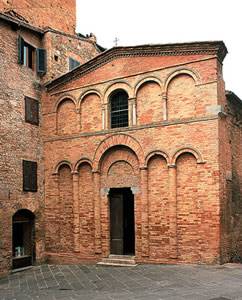 Coming from Piazza del Duomo, the Romanesque Church of St Bartolo it is located in Via San Matteo immediately after the Arch and the Palazzo della Cancelleria - recently renovated inside -, and after the steep street leading down to Via Capassi. The Church is devoted to St. Bartolo, a local saint who died in 1299 whilst attending the lepers at Lazzeretto di Cellole. A chapel in the Church of St. Agostino was later devoted to the saint as well.
Coming from Piazza del Duomo, the Romanesque Church of St Bartolo it is located in Via San Matteo immediately after the Arch and the Palazzo della Cancelleria - recently renovated inside -, and after the steep street leading down to Via Capassi. The Church is devoted to St. Bartolo, a local saint who died in 1299 whilst attending the lepers at Lazzeretto di Cellole. A chapel in the Church of St. Agostino was later devoted to the saint as well.
Its beautiful brick façade, built in 1173, has an elegant pattern with two raws of small blind arches of different size resting on semi-columns.
The portal is surmounted by a lintel decorated with the typical Greek Cross of the Knights of Jerusalm, who later developed into the Order of the Knights of Malta. Between the eleventh and the twelveth century, when it was part of village developping north of the first circle of the city walls, the church was devoted to St Matteo. For the same reason the current Chiesa di St Francesco, at the south end of the town, was given the name of the village in which it was included.
Church of San Girolamo
The small Church of St Girolamo is part of "Monastero delle monache Benedettine Vallombrosane", a monastery of cloistered nuns. The interior has got one nave, with the typical gate that separates the cloistered section and the altar, embellished with a beautiful panel by Vincenzo Tamagni depicting the Virgin and Child Enthroned with saints John The Baptist and Girolamo. The convent also houses sixteenth-century frescoes of the Florentine School that are not viewable.
Church of San Pietro in Forliano
 The small Church of San Pietro, commonly called San Piero, is located next to the large building of the Convent of the Augustinian Monks, but it is oriented in the opposite direction. It is one of the most ancient churches in San Gimignano (12th century), and it still belongs to the Diocese of Voterra, like Pieve di Cellole, Pieve di Libbiano, and Pieve di Canonica.
The small Church of San Pietro, commonly called San Piero, is located next to the large building of the Convent of the Augustinian Monks, but it is oriented in the opposite direction. It is one of the most ancient churches in San Gimignano (12th century), and it still belongs to the Diocese of Voterra, like Pieve di Cellole, Pieve di Libbiano, and Pieve di Canonica.
It has a simple brick façade with terra cotta patterns and one rose window surmounting the portal that is reached via four stone staircases. The one-nave interior has a raised presbytery, roof trusses, and interesting frescoes, including a very original scene with the Virgin holding hands the child Jesus between St. Peter and John the Baptist. This fresco was commonly thought a work by Lippo Memmi, but the author was probably his brother Federico.
Church of San Jacopo
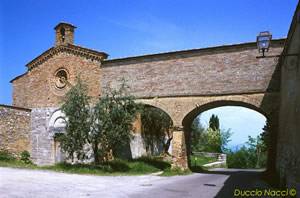 The Church of San Jacopo dei Templari is set at the end "Via Folgore da San Gimignano", by the exit from the city walls, and it is surrounded by olive trees. According to tradition, the Knights Templar of Jerusalem erected this Roman church back from the First Crusade, but it was certainly built later; it stands by the gate with the same name, on which the nuns had a covered overpass built in 1637 in order to access the church without being seen. The lower part of the façade consists of a travertine covering which includes the round-arched portal, and a lintel with a coat of arms of the Templar Order. The upper part of the façade is brick, with a finely decorated rose-window. The inside of this one-nave church houses frescoes depicting San Jacopo, to whom the church is dedicated. To be noted that all the churches of the Knights of Jerusalem, of the Knights Templar (defenders of the Jerusalem Temple), and of the Knights of Malta - all orders of warrior monks whose symbol was a Greek cross, clearly visible in San Gimignano on the three churches of San Jacopo, Santo Bartolo and San Francesco - had adjoining hospices to welcome the poor and the pilgrims travelling along the Via Francigena towards the destination they wanted to reach for themselves or for someone else.
The Church of San Jacopo dei Templari is set at the end "Via Folgore da San Gimignano", by the exit from the city walls, and it is surrounded by olive trees. According to tradition, the Knights Templar of Jerusalem erected this Roman church back from the First Crusade, but it was certainly built later; it stands by the gate with the same name, on which the nuns had a covered overpass built in 1637 in order to access the church without being seen. The lower part of the façade consists of a travertine covering which includes the round-arched portal, and a lintel with a coat of arms of the Templar Order. The upper part of the façade is brick, with a finely decorated rose-window. The inside of this one-nave church houses frescoes depicting San Jacopo, to whom the church is dedicated. To be noted that all the churches of the Knights of Jerusalem, of the Knights Templar (defenders of the Jerusalem Temple), and of the Knights of Malta - all orders of warrior monks whose symbol was a Greek cross, clearly visible in San Gimignano on the three churches of San Jacopo, Santo Bartolo and San Francesco - had adjoining hospices to welcome the poor and the pilgrims travelling along the Via Francigena towards the destination they wanted to reach for themselves or for someone else.
Chiesa di Sant'Agostino
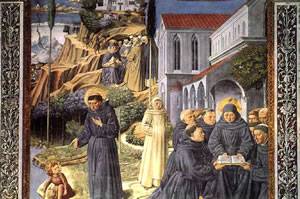 It can be reached from the Porta St. Matteo by passing along via Cellolese. Its very simple façade still retains the characteristics of its original architectural style. The door in the main façade is not used as the entrance, instead in order to enter the Church the door on the right hand side is generally used. The interior of the Church consists of a single great nave with three ogival apses.
It can be reached from the Porta St. Matteo by passing along via Cellolese. Its very simple façade still retains the characteristics of its original architectural style. The door in the main façade is not used as the entrance, instead in order to enter the Church the door on the right hand side is generally used. The interior of the Church consists of a single great nave with three ogival apses.
The roof is supported by a wooden framework. The construction of the Church of St. Agostino, with a single nave in Romanesque style with Gothic elements, began in 1280 and terminated on 31st March 1298 when it was consecrated by Cardinal Matteo D'Acquasparta. We owe to the Prior Fra Domenico Strambi, the building of the Cloister in the second half of the 15th century and the decoration of the Church in Renaissance style. Extremely interesting to see is the Chapel of the Blessed Bartolo, whose mortal remains are kept in a marble monument sculpted by Benedetto da Maiano in 1495. In 1500 Sebastiano Mainardi frescoed the Chapel's walls and vaults. Its terracotta floor is the work of Andrea della Robbia. Above the High Altar dominates "The Coronation of the Madonna and the Saints" painted in 1483 by Piero del Pollaiolo. The frescoes in the Chancel representing "Episodes from the life of St. Agostino" were painted by Benozzo Gozzoli between 1464 and 1465 with the help of two of his pupils Pier Francesco Fiorentino and Giusto d'Andrea who also painted the votive fresco of St. Sebastiano.
Other notable works of art in this church are the fragments remaining from a fresco by Bartolo di Fredi and a fresco showing "The Madonna" painted by Lippo Memmi in 1317 as well as the tablet representing "The Madonna and the Saints" painted by Fra Bartolomeo in 1530 and, in the sacristy, a wooden Crucifix dating from the 15th century.




 Italiano
Italiano





